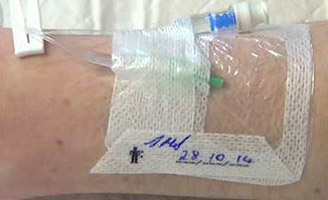Intravenous cannula (IV)

An IV is a small plastic tube, inserted into a vein, usually in your hand or arm.
An IV is a small plastic tube, inserted into a vein, usually in your hand or arm.
An IV is used to:
- provide fluids when you are dehydrated or can’t drink
- give a blood transfusion
- administer medications directly into your bloodstream. Some drugs work better this way.
Sometimes there are alternatives to an IV. You can discuss possible alternatives with the staff looking after you. Some treatments however can only be given, or are best given through an IV.
How is an IV inserted?
Your doctor, nurse or midwife, will:
- verify your name, ask about allergies, explain the procedure and obtain verbal consent
- wash their hands and wear gloves
- clean your skin with an antiseptic and use sterile equipment
- insert the IV into a vein using a fine needle, which is removed after the plastic tube is in place
- cover the IV site with a sterile dressing and write the date and time on the dressing.
Is it painful?
You may feel a sharp sting as the needle goes in, but once the IV is in place this will pass.
Can an IV fall out?
An IV is secured with a see-through dressing and is taped in place to prevent it falling out. Let staff know if you are concerned that the IV is not secure or if it becomes loose.
Are there any risks with having an IV?
- Infection: there is a risk of infection with any procedure that punctures the skin. As an IV sits directly in your bloodstream, this does increase the risk of infection, therefore frequent observation of the IV site and strict procedures to prevent infection must be followed by staff inserting and caring for your IV.
- Bruising and vein irritation: difficult or unsuccessful attempts to insert an IV can cause bruising and the plastic cannula may cause irritation to the vein.
- Blockage: sometimes the IV can become blocked by blood and may need to be removed.
Important: Let staff know straight away if you notice any redness, swelling, skin irritation or pain around your IV or if you feel hot, cold or shivery.
When will your IV be removed?
Your IV should be removed after 3 days, or as soon as you no longer require it. This is to reduce your risk of getting an infection. A new IV will be inserted if you still need it.
How do you care for your IV?
- Try not to touch the IV site or pull the tubing
- Try to keep the dressing dry
- It is ok to remind staff to clean their hands before touching your IV
- Your IV should not be disconnected from the fluid bag when you shower or are getting dressed, as unnecessary disconnections can increase your risk of infection
- Your IV is usually removed before you are discharged from hospital. If you notice any signs of infection at your old IV site or feel hot, cold or shivery, you should contact your GP or health provider.
- If you are to be discharged with an IV in place, you are to be given clear instructions relating to the care of the IV prior to your discharge.
Where to get help
- See your doctor
- Ring healthdirect on 1800 022 222
Last reviewed: 14-02-2025
Acknowledgements
Public Health
This publication is provided for education and information purposes only. It is not a substitute for professional medical care. Information about a therapy, service, product or treatment does not imply endorsement and is not intended to replace advice from your healthcare professional. Readers should note that over time currency and completeness of the information may change. All users should seek advice from a qualified healthcare professional for a diagnosis and answers to their medical questions.